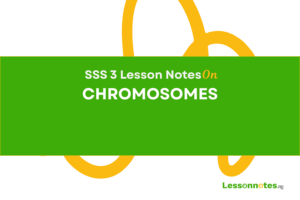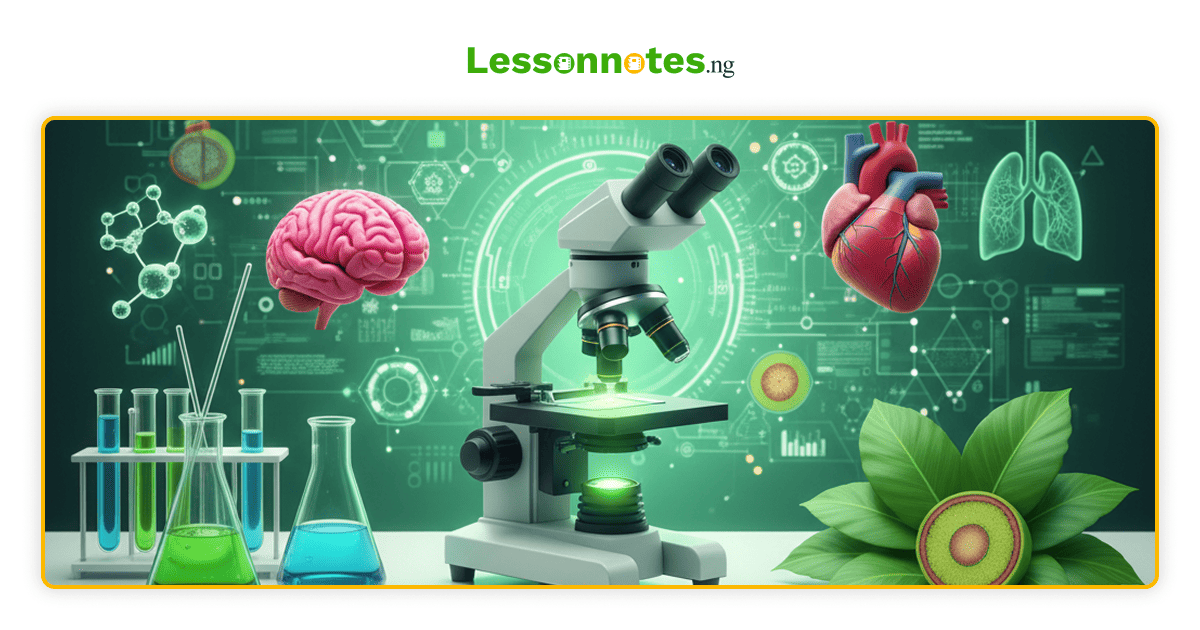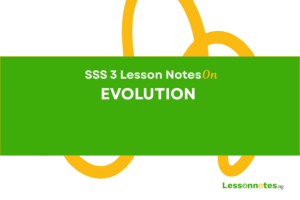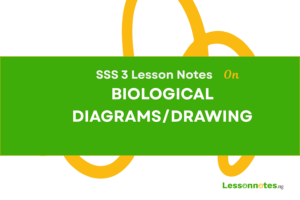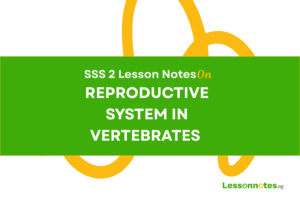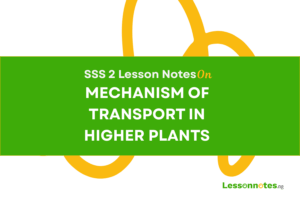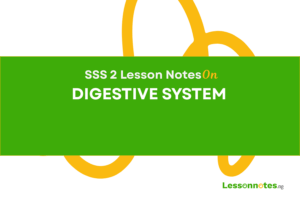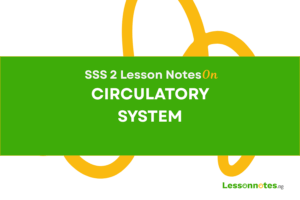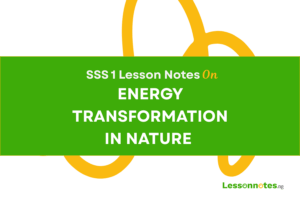Nutrition In Mammals SS1 Biology Lesson Note
Download Lesson NoteTopic: Nutrition In Mammals
ANIMAL NUTRITION
Animals generally cannot manufacture their food. Rather, they depend directly or indirectly on plants for their food. Hence they are called heterotrophs. Based on their food types, animals are grouped into three:
- Carnivores which feed on flesh or other animals e.g. lions.
- Herbivores which feed on plants e.g. goats.
- Omnivores, which feed on both plants and animals e.g. man.
CLASSES OF FOOD SUBSTANCES
Foods eaten by animals are generally classified into seven i. e.
- Carbohydrate
- Proteins
- Fat and oil
- Mineral Salt
- Vitamins
- Water
- Roughages
- CARBOHYDRATE
This is got from food like bread, yam rice etc. It consists of carbon, hydrogen and oxygen. Carbohydrates are of three types:
a) Monosaccharides (Simple sugars) which include glucose, fructose and galactose
b) Disaccharides (Reducing sugars) which include maltose, sucrose and lactose.
c) Polysaccharides (Complex sugars) e.g. starch, cellulose, chitin under the action of enzymes like ptyalin, maltase, lactase etc, and starch yields glucose as a product of its digestion. Excess carbohydrate is stored in the body in the form of glycogen in muscles and liver. This can be reconverted to glucose during starvation.
Importance of Carbohydrates
i. It gives animals energy.
ii. It provides heat needed to maintain body temperature
iii. It can be used for lubrication e.g. mucus.
iv. It provides the body with a strong framework e.g. exoskeleton in insects.
2.PROTEINS
These are complex molecules made up of smaller units called amino acids. Protein is made up of carbon, hydrogen, oxygen, nitrogen and sometimes phosphorus and sulphur. Food like egg, meat, fish, beans etc gives you protein. Proteins are broken down into amino acids under the action of enzymes like pepsin, rennin, trypsin and erepsin.
Importance of Proteins
i. Growth in young ones.
ii. Repair of worn-out tissues.
iii. Production of enzymes.
iv. Production of hormones.
v. It supports reproduction.
vi.It is for tissue and all formation i.e. body building.
- FATS & OIL (LIPIDS)
Fats are solid lipids at room temperature while oil is the liquid. Fat and oil consist of carbon, hydrogen and little oxygen. When digested, it gives rise to fatty acids and glycerol. Foods like palm oil, groundnut, and soybeans give fat and oil. Lipids are broken down into fatty acids and glycerol when acted upon by lipase enzymes.
Importance of Fat and Oil
i. It gives you energy even more than carbohydrates
ii. It supplies essential fatty acids to the body.
iii. It helps in the maintenance of body temperature
iv. It provides the body with fat-soluble vitamins
- MINERAL SALT
These are usually taken in very small quantities in the food we eat except sodium chloride (table salt) and iron tablets, which can be taken directly by man. The lack of these salts results in nutritional deficiency. The minerals include calcium, magnesium, potassium, Phosphorus, sulphur, chlorine, iron, Iodine, fluorine, manganese, copper, cobalt and sodium.
Importance of Mineral Salts
i. Regulate body metabolisms
ii. Components of bones and teeth
iii. Aids blood formation
iv. Control chemical reactions in the body
v.Aids the formation of enzymes and pigment
- VITAMINS
These are organic food substances needed by man and other animals in small quantities for normal growth and development. Lack of or inadequate supply of any of these vitamins results in nutritional deficiency.
Vitamins can be grouped into two:
- Water-soluble vitamins
- Fat-soluble vitamins
a) The water-soluble vitamins include: vitamins B complex and vitamin C. Vitamin B complex includes vitamins, B2, B3, B5, B6 and B12
b) Fat-soluble vitamins include vitamins A, D, E and K.
VITAMINS, SOURCE FUNCTIONS AND DEFICIENCY SYMPTOMS
| S/N | VITAMINS | SOURCES | DEFICIENCY |
| 1 | Vitamin A | Liver, eggs, fish, milk, palm oil, fish Vegetables | (i) Night blindness
(ii) Reduced resistance to disease |
| 2 | Vitamin B1 | Yeast, milk, beans, groundnut | Beri-beri (wasting of
Muscles), paralysis |
| 3 | Vitamin B2 | Yeast, milk, beans,
Ground nut |
i. Slow growth
(ii) Dermatitis |
| 4 | Vitamin B3 | Yeast, soya beans,
egg, milk, green Vegetables |
Pellagra |
| 5 | Vitamin B12 | Yeast, beans, milk,
Vegetables |
Pernicious
Anaemia |
| 6 | Vitamin C | Fresh fruits and
Green vegetables |
Scurvy |
| 7 | Vitamin D | Fish, milk, egg,
Liver, sun’s Ultraviolet rays |
i. Ricket;
ii. Osteomalacia |
| 8 | Vitamin E | Green vegetables,
Egg, butter, liver |
i. Sterility |
| 9 | Vitamin K | Fresh green vegetables, liver | i. Premature abortion
ii. Hemorrhage |
- WATER
This is of utmost importance to all organisms and it is made up of two elements, hydrogen and oxygen. Water can be obtained from food, rivers, streams, ponds etc. Water makes up 75% of the human body.
IMPORTANCE OF WATER
- Metabolic activities of the body of animals.
- Digestion of food.
- Maintenance of body temperature.
- It is a medium of transportation for all nutrients.
- It helps to maintain the osmotic balance in body tissues.
- It helps in the excretion of metabolic waste from the body e.g. urine.
- ROUGHAGES
These are indigestible fibrous materials obtained from vegetables, fruit, carbohydrates and proteins. Roughages aid digestion, a lack of which can lead to constipation.
BALANCED DIET
A balanced diet is a diet containing a correct proportion of all the food substances. On a general note, a balanced diet contains 15% protein, 15% fat and oil, 10% vitamins, minerals and water and 60% carbohydrate. Once a food is taken at these proportions, there is normal growth and development in the body.
FUNCTIONS OF BALANCED DIET
- It makes us healthy.
- It gives the ability to be resistant to diseases
- It makes available energy needed to carry out all biological activities.
- It prevents malnutrition and deficiency symptoms. For example, a diet that lacks protein results in a nutritional disease called kwashiokor in children.
The protein-deficient child has the following features:
- Retarded growth.
- Loss of weight.
- Swollen legs effect (oedema).
- Cracked / split stomach and thin legs etc.
DIGESTIVE ENZYMES
Enzymes are organic (protein) catalysts produced by living cells which help to speed up and slow down the rate of chemical reactions. Digestive enzymes aid in the breaking down of complex food substances into simple, soluble and diffusible forms.
Enzymes have the following characteristics.
- Enzymes are soluble
- Enzymes are protein
- They are specific in their actions
- Enzymes are sensitive to temperature i. e. they work best between 35oC to 40oC
- Enzymes are PH specific
- Enzymes bring about reversible reactions
- Enzymes need co-enzymes to activate them and can be inactivated by inhibitors such as mercury and cyanide
CLASSES AND FUNCTIONS OF ENZYMES
Digestive enzymes are classified based on the type of food they act upon. These include:
- Proteases e. g. pepsin, rennin, trypsin and erepsin. They act on protein.
- Amylases e. g. ptyalin, lactase, maltase, sucrose. They act on carbohydrates
- Lipases which act on lipids (fats and oils)
ASSIGNMENT
- Vitamins are organic food substances required by animals in ____ quantity. a. no B. small C. large D. high
- The following except one are fat-soluble vitamins A. vitamin A B. Vitamin B C. Vitamin K D. Vitamin E
- One of the following food substances is indigestible in man A. protein B. lipids C. roughages D. carbohydrates
- The highest source of energy is from _______ A. carbohydrate B. proteins C. lipids D. vitamins
- Rickets (poor bone formation) in children is a deficiency symptom of ____ A. potassium B. calcium C. chlorine D. manganese.
- Make a table of food tests showing the column of food, the test, observation & inference.
- Make a table of important mineral elements in animals, their functions and deficiency symptoms


